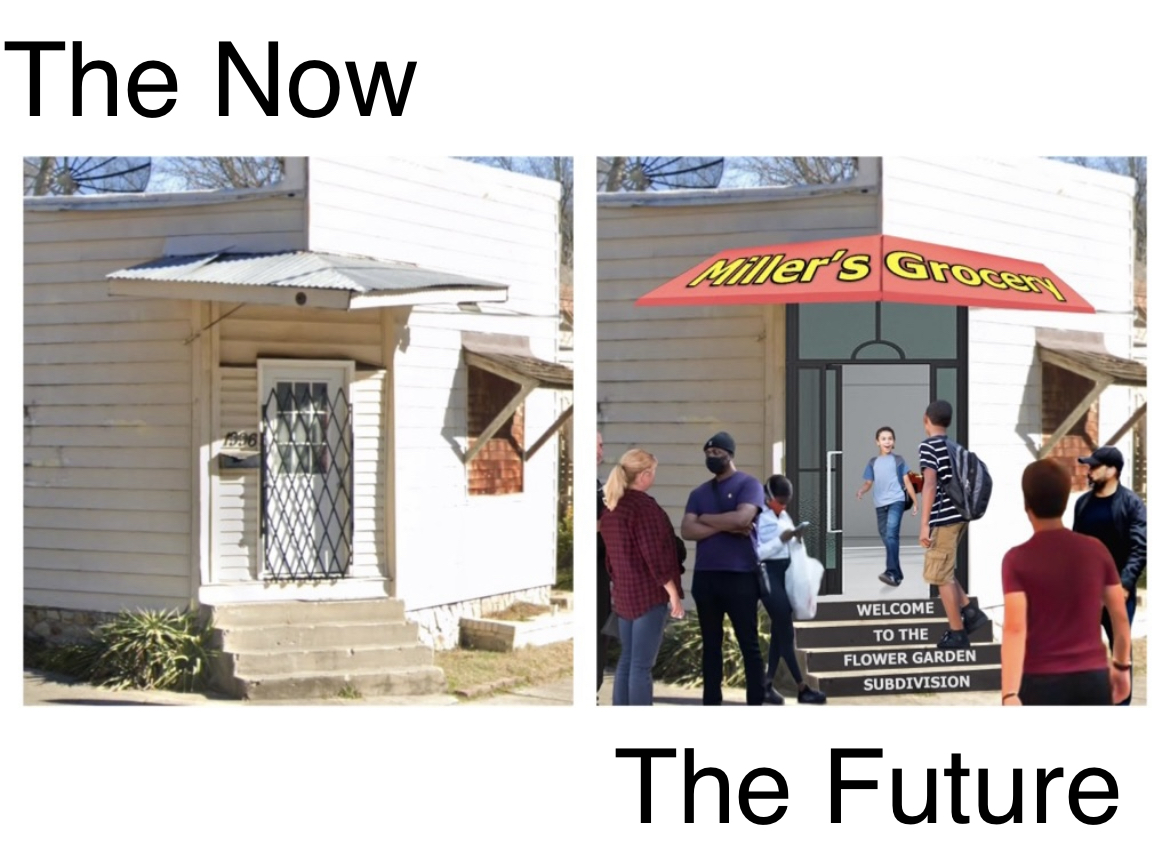Reimagining the Flower Garden Subdivision
THE FLOWER GARDEN SUBDIVISION NEIGHBORHOOD REVITALIZATION & REBRANDING PROJECT
Leader
Kendall Munson
Location
1996 E McLemore Ave MEMPHIS, TN 38114
About the project
Situated at the intersection of McLemore and Rembert is a building that was once a family-owned corner store Miller’s Grocery. This Flower Garden Subdivision community landmark has served the community for years. To this day the building is still referred to as “the Miller’s store”. As we embark on a mission to revitalize and rebrand the community, it is befitting that we pay homage to this community landmark. It is our vision to erect a mural in honor of the legacy of Miller’s Grocery to serve as a visual representation of the community.
The Steps
- Finalize the mural concept: Work closely with the artists, community members, and any relevant stakeholders to refine and finalize the mural concept. Incorporate any feedback or suggestions gathered during the planning stage.
- Develop a detailed design: Collaborate with the artists to create a comprehensive design plan for the mural. This will include specific dimensions, color schemes, and any intricate details or elements that will be incorporated into the artwork.
- Schedule the painting timeline: Create a detailed timeline that outlines the specific dates and times for the mural painting process. Coordinate with the artists, volunteers, and community members to ensure everyone is aware of the schedule and availability.
- Document the process: We will document the mural painting process through photographs, videos, or written accounts. This documentation will be used for promotional purposes, project reports, and future grant applications.
- Communicate with stakeholders: Maintain open lines of communication with the funding organizations, sponsors, and other stakeholders involved in the project. Provide regular updates on the progress, share photos or videos, and express gratitude for their support.
- Organize community engagement events: Plan events or activities to engage the community throughout the mural painting process. This will include open painting sessions, artist talks, or community gatherings to celebrate milestones.
- Conduct regular site visits: Visit the mural site regularly to ensure that the painting is progressing as planned and that the artists have the necessary support. Address any maintenance or logistical issues promptly.
- Celebrate the completion: Once the mural is finished, we will organize a community event to officially unveil and celebrate the artwork. We will invite the artists, volunteers, funders, local officials, and community members to acknowledge their contributions and enjoy the finished piece.
- Express gratitude: Show appreciation to all those involved in the project, including the artists, volunteers, funders, sponsors, and community members. Thank them for their dedication, support, and collaboration throughout the process.
Why we‘re doing it
The Flower Garden Subdivision neighborhood has suffered from disinvestment over the years. Our goal with this project is to jumpstart the revitalization and rebranding of the Flower Garden Subdivision and bring to the area the sense of community pride that the neighboring communities, Orange Mound, Cooper Young, and Glenview have.
We envision erecting the mural at the intersection of McLemore and Rembert to have the following impact:
- Social Impact:
- Community Engagement: The process of creating a mural often involves active community participation, fostering a sense of ownership and empowerment. It provides a platform for residents to come together, collaborate, and express their collective voice. This engagement can strengthen social bonds, promote dialogue, and address social issues through artistic expression.
- Identity and Pride: Murals can celebrate local culture, history, and diversity, instilling a sense of pride and belonging among community members. By showcasing the unique aspects of a neighborhood, murals can contribute to positive identity formation and foster a stronger community spirit.
- Economic Impact:
- Neighborhood Revitalization: Murals can be part of broader efforts to revitalize a neighborhood, attracting visitors, tourists, and potential investors. The enhanced visual appeal and cultural vibrancy can make the area more attractive for businesses, leading to increased economic activity and opportunities.
- Environmental Impact:
- Beautification and Green Spaces: Murals can transform blank walls or neglected spaces into visually appealing and vibrant areas. By revitalizing the physical environment, murals contribute to beautification efforts, making neighborhoods more attractive and inviting. Additionally, murals can incorporate themes of environmental awareness, promoting sustainability, and encouraging a connection with nature.
- Urban Renewal and Safety: Murals in previously run-down or unsafe areas can contribute to urban renewal. The presence of murals can deter vandalism and crime, creating a safer and more welcoming environment for residents. This can also help activate underutilized spaces, promoting positive social interactions and increased foot traffic.

